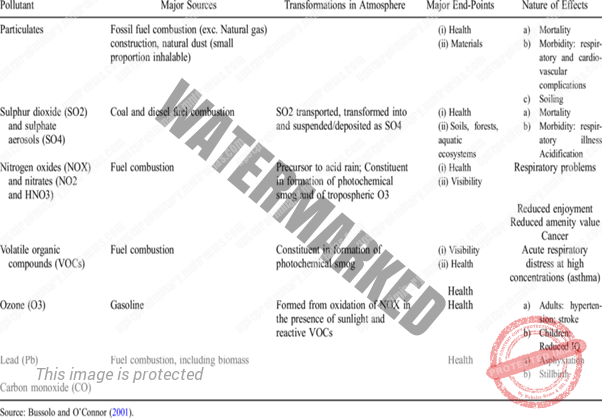- AIR POLLUTION
- AIR POLLUTION AND ITS SOURCES
- MAJOR POLLUTANTS
UNIT 4 – ENVIRONMENTAL DEGRADATION – PART 2
Hence the let us study the various pollution its sources, impact and reduction strategies in the following section.
4.2 AIR POLLUTION
The origin of air pollution on the earth can be traced from the times when man started using firewood as a means of cooking and heating. Hippocrates has mentioned air pollution in 400 BC.
With the discovery and increasing use of coal, air pollution became more pronounced especially in urban areas. It was recognized as a problem 700 years ago in London in the form of smoke pollution.
During the industrial revolution due to the use of coal in industries air pollution became a major problem in London in the 19th century. The earliest recorded major disaster was the ‘London Smog’ that occurred in 1952 that resulted in more than 4000 deaths due to the accumulation of air pollutants over the city for five days. Air pollution began to increase in the beginning of the twentieth century with the development of the transportation systems and large-scale use of petrol and diesel.
The severe air quality problems due to the formation of photochemical smog from the combustion residues of diesel and petrol engines were felt for the first time in Los Angeles. Pollution due to auto-exhaust remains a serious environmental issue in many developed and developing countries including India. Air pollution is now considered to be the world’s largest environmental health threat, accounting for 7 million deaths around the world every year.
AIR POLLUTION AND ITS SOURCES
Air pollution occurs due to the presence of undesirable solid or gaseous particles in the air in quantities that are harmful to human health and the environment.
Natural causes such as volcanoes, which release ash, dust, Sulphur and other gases, or by forest fires that are occasionally naturally caused by lightning. However, unlike pollutants from human activity, naturally occurring pollutants tend to remain in the atmosphere for a short time and do not lead to permanent atmospheric change.
Primary Pollutants – Pollutants that are emitted directly from identifiable sources are produced both by Natural Events (for example, dust storms and volcanic eruptions) and human activities (emission from vehicles, industries, etc.). These are called primary pollutants. There are five primary pollutants that together contribute about 90 percent of the global air pollution.
- Carbon Oxides (CO And CO2)
- Nitrogen Oxides
- Sulphur Oxides
- Volatile Organic Compounds (Mostly Hydrocarbons)
- Suspended Particulate Matter.
Secondary pollutants – Pollutants that are produced in the atmosphere when certain chemical reactions take place among the primary pollutants are called secondary pollutants. A secondary pollutant is not directly emitted as such, but forms when other pollutants (primary pollutants) react in the atmosphere.
Examples of a secondary pollutant include ozone, which is formed when hydrocarbons (HC) and nitrogen oxides (NOx) combine in the presence of sunlight; NO2, which is formed as NO combines with oxygen in the air; and acid rain, which is formed when Sulphur dioxide or nitrogen oxides react with water, sulfuric acid, nitric acid, carbonic acid, etc.
MAJOR POLLUTANTS
CARBON MONOXIDE
It is a Colourless, Odourless And Toxic Gas produced when organic materials such as natural gas, coal or wood are incompletely burnt. Vehicular exhausts are the single largest source of carbon monoxide. Vehicles are also poorly maintained and several have inadequate pollution control equipment resulting in release of greater amounts of carbon monoxide.
Carbon monoxide is however not a persistent pollutant. Natural processes can convert carbon monoxide to other compounds that are not harmful. Therefore the air can be cleared of its carbon monoxide if no new carbon monoxide is introduced into the atmosphere.
- Sulphur oxides – are produced when sulphur containing fossil fuels are burnt.
- Nitrogen oxides – are found in vehicular exhausts. Nitrogen oxides are significant, as they are involved in the production of secondary air pollutants such as ozone.
- Hydrocarbons are a group of compounds consisting of carbon and hydrogen atoms. They either evaporate from fuel supplies or are remnants of fuel that did not burn completely. Hydrocarbons are washed out of the air when it rains and run into surface water. They cause an oily film on the surface and do not as such cause a serious issue until they react to form secondary pollutants. Using higher oxygen concentrations in the fuel air mixture and using valves to prevent the escape of gases, fitting of catalytic converters in automobiles, are some of the modifications that can reduce the release of hydrocarbons into the atmosphere.
- Particulates are small pieces of solid material (for example, smoke particles from fires, bits of asbestos, dust particles and ash from industries) dispersed into the atmosphere.
The effects of particulates range from soot to the carcinogenic (cancer causing) effects of asbestos, dust particles and ash from industrial plants that are dispersed into the atmosphere. Repeated exposure to particulates can cause them to accumulate in the lungs and interfere with the ability of the lungs to exchange gases.
- Lead is a major air pollutant that remains largely unmonitored and is emitted by vehicles. High lead levels have been reported in the ambient air in metropolitan cities. Leaded petrol is the primary source of airborne lead emissions in Indian cities.

